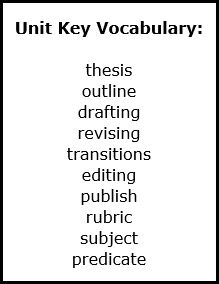
PDF File
Course Overview
This course is set up to prepare students for the AIR English Language Arts II Assessment. Students will apply the writing process to develop argumentative/persuasive/opinion, informative/expository/explanatory, and literary analysis essays. Additionally, students will read, analyze, and respond to various literary genres including argumentative texts, historical documents, poetry, short stories, dramas, and other genres that appear on the AIR Assessment. Each unit coaches students through how to approach reading each genre and how to answer the questions that appear on the AIR Assessment. Finally, at the end of every unit, students will review grammar and language conventions, including parts of a sentence parts, sentence types, parallel structure, capitalization, and punctuation.
WRITING: THE BASICS - THE WRITING PROCESS
 |
Unit Overview
Welcome!! In this class, you will be learning about reading and writing specific to the AIR Language Arts II Assessment. The first unit will provide an overview of the basics of the writing process and how to approach writing on the AIR Assessment. At the end of the unit, you will review subjects and predicates. Above you will find a list of key vocabulary for this unit.
*Download the attached pdf to take notes during the lesson. 
Writing is a vehicle for you to show what you know about a topic or a text. On the AIR Assessment, you will write to show what you read about several texts. In order to receive credit for having great ideas, you must convey them in a focused and skillful manner.
As you look at a writing task for the first time, you may feel slightly overwhelmed. You may think:
It seems like a tough job. That's why the best writers break their writing up into steps. Each step has different elements for you to focus on, so you never become too overwhelmed by the task in front of you. No matter what the task, use the following steps to guide you through the process of composing a thoughtful and polished piece of writing for the AIR Assessment.
1. Read & Take Notes
The first step to writing on the AIR ELA Assessment is to read the passages that serve as a stimulus for the writing task and to take notes based on the prompt.
Below is an example of a type of note-taking we will do in this course.
|
2. Plan
In the planning stage, you set the direction for your essay. This means organizing your notes into an outline and deciding exactly what you want to say about the task.
When you plan your writing, you will first need to decide your thesis, or a statement of your main idea. The thesis is a roadmap for the rest of the essay.
Different types of writing require different types of thesis statements...
|
One way to organize is to create an outline that clearly and briefly describes what you plan to include in the different parts of your essay. When you develop an outline or any other type of plan for your writing, you do not have to write in complete sentences. Feel free to record your ideas in words and phrases. You are making a map to use as the basis for a stronger structure when you write a draft. In the draft stage and the stages following it, you can flesh out your paragraphs with well-constructed sentences.
3. Draft
In the drafting stage of writing, you form all of your ideas as well-constructed sentences and paragraphs with your audience and purpose in mind. These paragraphs must be organized in a logical way, or readers might not understand what you are trying to communicate. Luckily, you have already collected and organized many ideas in your writing plan. Now it is a matter of turning that plan into a well-developed response. Almost all writing you do will use a simple framework, including an introduction, a body, and a conclusion.
4. Revise & Edit
Revising is the writing stage where you look for ways to improve the focus, structure, ideas, and language. When revising, you will reread your essay to make sure all of the details fit under the topic of the paragraphs they are in; you will make sure to use a mix of long and short sentences; and you will be sure to include transitions to connect your ideas.
Transitions are signposts that help show your reader where you are going and where you have been. Common transitions include: for example, but, although, however, as a result, first, and finally.
Editing your writing involves checking for correct grammar, spelling, punctuations, and capitalization.
5. Publish
When you publish your AIR ELA writing, you complete your essay and turn it in for grading. Before turning it in, be sure to fix any mistakes you found in the editing stage and look over the grading rubric. Check to make sure you included everything outlined on the rubric.
A rubric is a scoring guide used to evaluate the quality of students' constructed responses. Rubrics usually contain evaluative standards, quality definitions for those standards at particular levels of achievement, and a scoring strategy.
Below is an example of a rubric.
|
STOP! Complete Questions 1 through 12 in the questions section.
Grammar Lesson1: SUBJECTS & PREDICATES
EXAMPLE: Suddenly, the rat heard a low growl and a hiss.
SUBJECT= the rat
PREDICATE= heard
Click on the following link for a video further explaining subjects and predicates.

Let's Practice
1. Identify the SUBJECT and the PREDICATE in the following sentence.
|
2. Identify the SUBJECT and the PREDICATE in the following sentence.
|
STOP! Complete Questions 13 through 18 in the questions section.
 |
| Complete Subjects and Predicates |
| Complete Subjects and Predicates Answer Key |